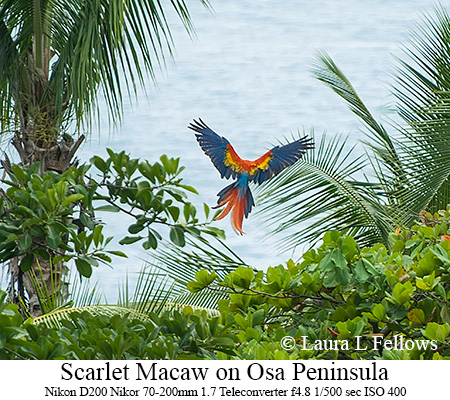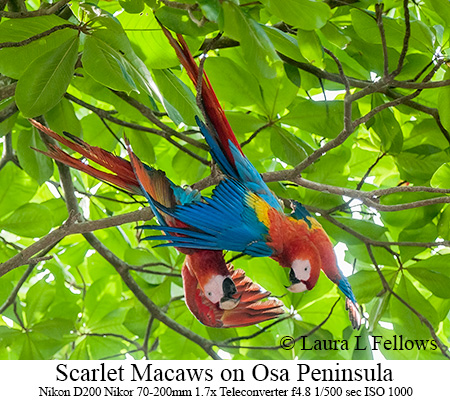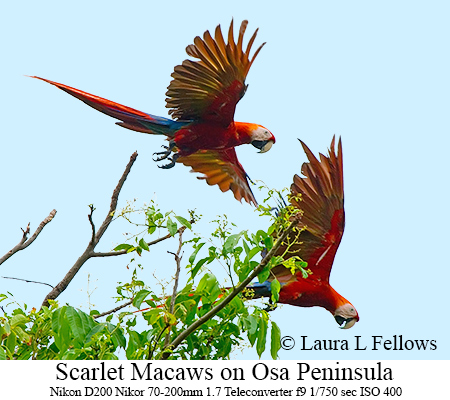Scarlet Macaws Living Free

ARTICLES
SCARLET
MACAWS
By Laura L Fellows
Scarlet Macaws are best known as caged birds who have great appeal to bird fanciers. Their beautiful plumage and endearing personalities have made them popular pets since at least 1100 AD when captive macaws were prized by Pueblo Indians. Far fewer people have seen and known Scarlet Macaws in the wild. Viewing and photographing Scarlet Macaws living free is an exhilarating feeling for those fortunate enough to experience it.
Scarlet Macaws were once found throughout Costa Rica, but their range has diminished and their population has greatly declined as a result of deforestation. Only two extant populations remain in the country, one near Carara National Park on the central Pacific coast and the other on Osa Peninsula in the south. The largest population consists of several hundred individuals on Osa Peninsula, an area infrequently visited by the many travelers to Costa Rica.

When I found myself with a couple days of free time at the end of a tour I conducted in central Costa Rica, I jumped at the chance of photographing wild Scarlet Macaws. I soon left the hustle and congestion of San Jose behind and was winging my way south in a twin-engine turboprop plane that delivered me to Puerto Jimenez, a port town on the Osa Peninsula. This part of Costa Rica is much more tropical than farther north and is a wild and remote place. Roads are few and most of the peninsula remains forested. Until fairly recently the area was visited mainly by loggers and professional poachers seeking to exploit the abundant natural resources found on the peninsula. Gold was discovered in 1980, which brought in several thousand adventurers seeking their fortunes. The miners dynamited river beds, polluted rivers, and cut down numerous trees, causing so much damage that the government expelled them from the area in 1986. Following a year of demonstrations and protests, most of the miners left though a few continued to look for gold in more remote areas while others turned to ecotourism to make a living. Today much of Osa Peninsula is encompassed by Corcovado National Park, which was set up to protect one of the largest tracts of primary rainforest remaining in Central America. The area remains under serious threat from illegal logging and poaching of exotic animals because the Costa Rican government is ill-equipped to enforce existing regulations and prevent such activities from taking place. Several private organizations are actively raising money to pay park rangers to patrol the area and take action against illegal activities, but much more remains to be done. Ecotourism is an important facet of this effort, as it creates economic incentive to protect the region and take strong action against the destructive impacts of logging and poaching.

After arriving at Puerto Jimenez, I had one thought in mind - photographing Scarlet Macaws in the wild. My goal was to capture images of Scarlet Macaws as living and feeling beings in their natural habitat. I feel a strong empathy for birds in the wild, and I want to capture that feeling in my images. I refer to my vision as "Environmental Portraiture" (see Nature Photographer, December 2007), a term first coined in 1942 by famed photographer Arnold Newman. As Newman described his concept during an interview with American Photo Magazine, "The surroundings had to add to the composition and the understanding of the person. No matter who the subject was, it had to be an interesting photograph. Just to simply do a portrait of a famous person doesn't mean a thing." My vision is to apply this same concept to bird photography.
I arrived on the southern coast of Osa Peninsula with this vision in mind. A single road connects Puerto Jimenez with the Pacific coastal area and the main entrance to Corcovado National Park. To reach my destination at the end of this road, I shared a cab ride with a French man who was heading to a tent camp within the park. Our "cab" was actually a 4-wheel-drive pickup truck, and our rather adventurous ride was along a rough dirt road surrounded by second growth and primary rainforest. After a slow and bumpy 2-hour drive that included seven river crossings, I arrived at an environmentally sensitive lodge perched atop a bluff overlooking the Pacific Ocean.

As I stood on the veranda of the lodge, I was enthralled by the Scarlet Macaws flying along the bluff below me. It was one of the most emotionally uplifting experiences I have felt during the many years I've spent as a photographer. Macaws flew in tandem pairs above the tree canopy, swooped down among the palm trees, and landed in the almond trees to feed. They perched in the tops of trees where mated pairs preened and groomed each other, seemingly in loving fashion, a behavior serving to reinforce their life-long pair bonds in addition to ridding each other of parasites. I was mesmerized by the color and grace of these extraordinary birds, and I spent my entire stay at the lodge watching their behavior and making photographs of them.
I was shooting with my Nikon D200, 70-200 mm VR zoom lens, and 1.7X teleconverter. I didn't use a tripod because I wanted to capture images of macaws in flight as well as perched, and their rapid flight made a tripod impractical. The resulting images do more than show the physical beauty of Scarlet Macaws. They capture special moments as the macaws go about their daily lives, and they express the emotional connection I felt as I photographed them.

My first image captures the tropical world of macaws as a single individual swoops down among the palms with the Pacific Ocean in the background. It captures the beauty of Scarlet Macaw in its natural world, where the primary colors of its plumage are framed and enhanced by the palm trees, ocean, and sky surrounding the bird. My second image shows the intimacy of a mated pair as they were "kissing" in a treetop. Males and females frequently reinforce their pair bonds by preening each other and touching bills, and this behavior is an important part of their daily lives. My third image shows a mated pair cavorting in the trees while reinforcing their pair bond. My final image displays the grace and beauty of macaws taking flight as a male follows his mate. The image captures the loyalty and perhaps protectiveness shown by mated males. Life-long pair bonds are a cornerstone of macaw life and essential to their breeding success. As I photographed these mated pairs I couldn't avoid thinking with great sadness about the harm caused by poaching individuals for the pet trade. Additional images as well as information about how to visit Osa Peninsula and make your own photographs of these wonderful birds can be found on my website at www.exoticbirding.com.



